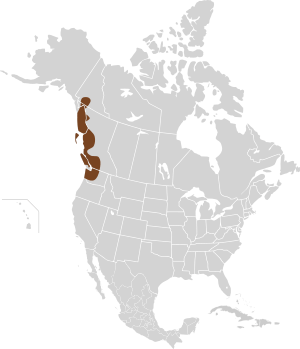Northwestern deer mouse facts for kids
Quick facts for kids Northwestern deer mouse |
|
|---|---|
| Conservation status | |
| Scientific classification | |
| Genus: |
Peromyscus
|
| Species: |
keeni
|
 |
|
| Synonyms | |
|
oreas Bangs, 1898 |
|
The northwestern deer mouse or Keen's mouse (Peromyscus keeni) is a small rodent that lives in North America. It belongs to the family Cricetidae, which includes many types of mice and hamsters. This mouse is found in parts of Canada, specifically British Columbia, and in the United States, in Alaska and Washington.
This mouse was named in 1894 after the Reverend John Henry Keen. He was a missionary and naturalist who collected many animal specimens in British Columbia.
Contents
What is a Northwestern Deer Mouse?
The northwestern deer mouse is a type of deer mouse, known for its agility and speed. It is a nocturnal animal, meaning it is most active at night. These mice are important parts of their ecosystems, serving as food for many predators and helping to spread seeds.
Appearance
Northwestern deer mice are small, usually about 7 to 10 centimeters (3 to 4 inches) long, not including their tail. Their tails can be as long as their bodies. They have soft fur that is typically reddish-brown or grayish-brown on their backs and sides. Their bellies and feet are white, which helps them blend into their surroundings. They have large eyes and ears, which are useful for seeing and hearing in the dark.
Where They Live (Habitat and Range)
These mice prefer to live in forests, woodlands, and bushy areas. They can be found in both coastal and inland regions. They make their homes in burrows underground, under logs, or in hollow trees. Sometimes, they might even live in old buildings.
Their range stretches along the Pacific coast of North America. This includes:
- Coastal British Columbia in Canada
- Southeastern Alaska in the United States
- Western Washington in the United States
The map in the infobox shows the specific areas where these mice are found.
What They Eat (Diet)
The northwestern deer mouse is an omnivore, which means it eats both plants and animals. Their diet mostly includes:
- Seeds
- Nuts
- Berries
- Insects
- Fungi
They often store food in their burrows for the winter months, when food might be harder to find.
Behavior and Lifestyle
These mice are shy and mostly active during the night. They are very good at climbing and running. They use their long tails for balance, especially when climbing trees or moving quickly.
They build nests for sleeping and raising their young. These nests are often made from soft materials like grass, leaves, and fur. Northwestern deer mice are generally solitary, but they might share burrows during cold weather to stay warm.
Reproduction and Life Cycle
Northwestern deer mice can reproduce several times a year, especially during warmer months. A female mouse can have multiple litters of pups.
- A litter usually has 3 to 7 pups.
- The pups are born blind and helpless.
- They grow very quickly and are weaned (stop drinking milk) after about 3 to 4 weeks.
- They become independent shortly after and can start reproducing themselves within a few months.
Their lifespan in the wild is usually short, often less than a year, because of predators and harsh environmental conditions.
Predators
Many animals hunt the northwestern deer mouse. These predators include:
- Owls
- Hawks
- Snakes
- Weasels
- Foxes
- Coyotes
- Cats
Their quick movements and nocturnal habits help them avoid some of these dangers.
Conservation Status
The northwestern deer mouse is listed as "Least Concern" by the International Union for Conservation of Nature (IUCN). This means that their populations are stable and they are not currently at risk of extinction. They are common in their natural habitats.
See also
 In Spanish: Peromyscus keeni para niños
In Spanish: Peromyscus keeni para niños


